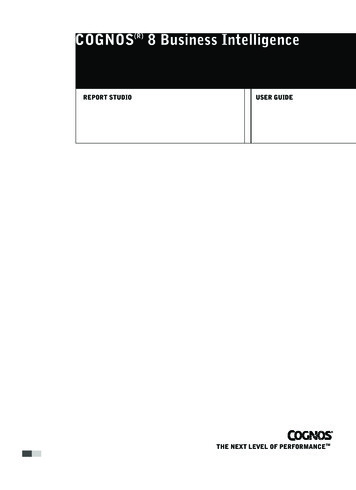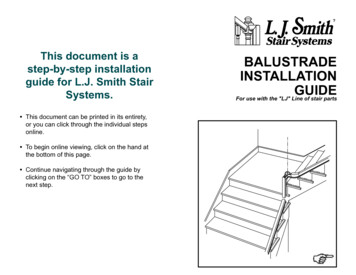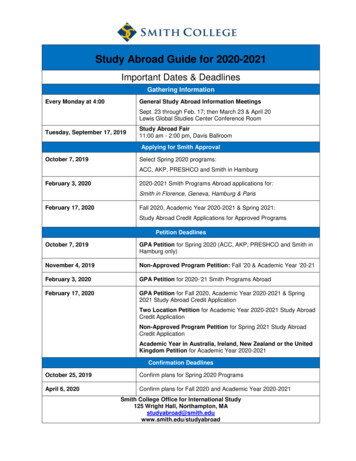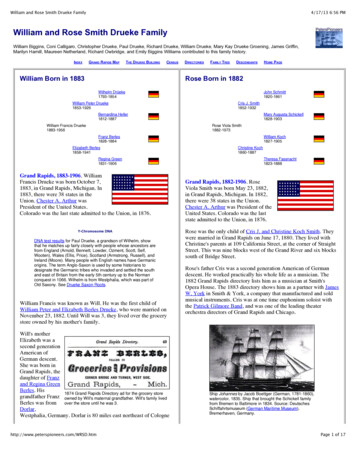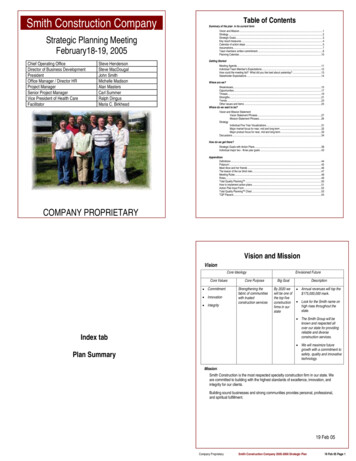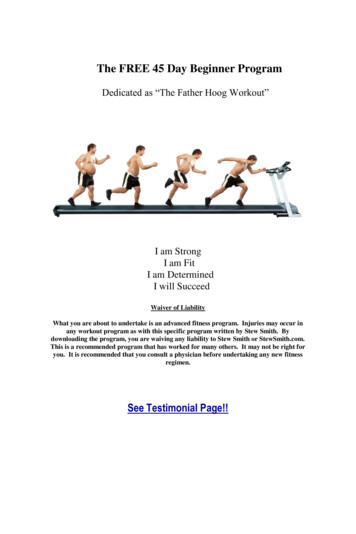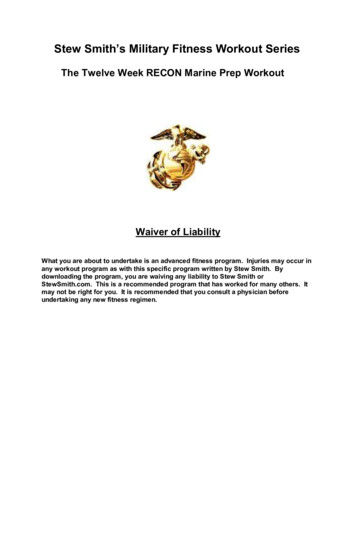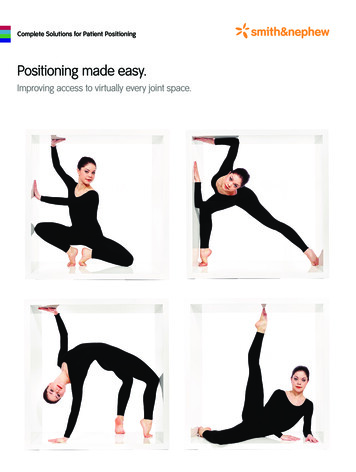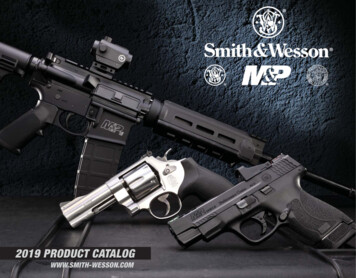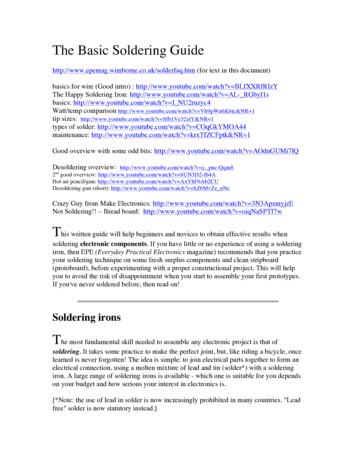
Transcription
The Basic Soldering m (for text in this document)basics for wire (Good intro) : http://www.youtube.com/watch?v BLfXXRfRIzYThe Happy Soldering Iron: http://www.youtube.com/watch?v AL- RGbyf1sbasics: http://www.youtube.com/watch?v I NU2ruzyc4Watt/temp comparison http://www.youtube.com/watch?v Vh9pWu6K6tc&NR 1tip sizes: http://www.youtube.com/watch?v Sfb1Ve52ztY&NR 1types of solder: http://www.youtube.com/watch?v COqGkYMOA44maintenance: http://www.youtube.com/watch?v krxTfZCFptk&NR 1Good overview with some odd bits: http://www.youtube.com/watch?v AOdnGUMi7lQDesoldering overview: http://www.youtube.com/watch?v j- pnc-Qqm82nd good overview: http://www.youtube.com/watch?v 8UN3D2-f64AHot air pencil/gun: http://www.youtube.com/watch?v AxYhF6Ab2CUDesoldering gun (short): http://www.youtube.com/watch?v 8Z6MvZz uNcCrazy Guy from Make Electronics: http://www.youtube.com/watch?v 3N3ApzmyjzENot Soldering!! – Bread board: http://www.youtube.com/watch?v oiqNaSPTI7wThis written guide will help beginners and novices to obtain effective results whensoldering electronic components. If you have little or no experience of using a solderingiron, then EPE (Everyday Practical Electronics magazine) recommends that you practiceyour soldering technique on some fresh surplus components and clean stripboard(protoboard), before experimenting with a proper constructional project. This will helpyou to avoid the risk of disappointment when you start to assemble your first prototypes.If you've never soldered before, then read on!Soldering ironsThe most fundamental skill needed to assemble any electronic project is that ofsoldering. It takes some practice to make the perfect joint, but, like riding a bicycle, oncelearned is never forgotten! The idea is simple: to join electrical parts together to form anelectrical connection, using a molten mixture of lead and tin (solder*) with a solderingiron. A large range of soldering irons is available - which one is suitable for you dependson your budget and how serious your interest in electronics is.[*Note: the use of lead in solder is now increasingly prohibited in many countries. "Leadfree" solder is now statutory instead.]
Electronics catalogues often include a selection of well-known brands of soldering iron.Excellent British-made ones include the universally popular Antex, Adcola and Litesoldmakes. Other popular brands include those made by Weller and Ungar. A very basicmains electric soldering iron can cost from under 5 (US 8), but expect a reasonablemodel to be approximately 10- 12 (US 16 - 20) - though it's possible to spend intothree figures on a soldering iron "station" if you're really serious! Check some suppliers'catalogues for some typical types. Certain factors you need to bear in mind include:Voltage: most irons run from the mains at 240V. However, low voltage types (e.g. 12Vor 24V) generally form part of a "soldering station" and are designed to be used with aspecial controller made by the same manufacturer.Wattage: Typically, they may have a power rating of between 15-25 watts or so, which isfine for most work. A higher wattage does not mean that the iron runs hotter - it simplymeans that there is more power in reserve for coping with larger joints. This also dependspartly on the design of the "bit" (the tip of the iron). Consider a higher wattage ironsimply as being more "unstoppable" when it comes to heavier-duty work, because itwon't cool down so quickly.Temperature Control: the simplest and cheapest types don't have any form oftemperature regulation. Simply plug them in and switch them on! Thermal regulation is"designed in" (by physics, not electronics!): they may be described as "thermallybalanced" so that they have some degree of temperature "matching" but their output willotherwise not be controlled. Unregulated irons form an ideal general purpose iron formost users, and they generally cope well with printed circuit board soldering and generalinterwiring. Most of these "miniature" types of iron will be of little use when attemptingto solder large joints (e.g. very large terminals or very thick wires) because thecomponent being soldered will "sink" heat away from the tip of the iron, cooling it downtoo much. (This is where a higher wattage comes in useful.)A proper temperature-controlled iron will be quite a lot more expensive - retailing at say 40 (US 60) or more - and will have some form of built-in thermostatic control, toensure that the temperature of the bit (the tip of the iron) is maintained at a fixed level(within limits). This is desirable especially during more frequent use, since it helps toensure that the temperature does not "overshoot" in between times, and also guaranteesthat the output will be relatively stable. Some irons have a bimetallic strip thermostatbuilt into the handle which gives an audible "click" in use: other types use all-electroniccontrollers, and some may be adjustable using a screwdriver.Yet more expensive still, soldering stations cost from 70 (US 115) upwards (the ironmay be sold separately, so you can pick the type you prefer), and consist of a completebench-top control unit into which a special low-voltage soldering iron is plugged. Someversions might have a built-in digital temperature readout, and will have a control knob toenable you to vary the setting. The temperature could be boosted for soldering largerjoints, for example, or for using higher melting-point solders (e.g. silver solder). Theseare designed for the most discerning users, or for continuous production line/ professional
use. The best stations have irons which are well balanced, with comfort-grip handleswhich remain cool all day. A thermocouple will be built into the tip or shaft, whichmonitors temperature.Anti-static protection: if you're interested in soldering a lot of static-sensitive parts (e.g.CMOS chips or MOSFET transistors), more advanced and expensive soldering ironstations use static-dissipative materials in their construction to ensure that static does notbuild up on the iron itself. You may see these listed as "ESD safe" (electrostaticdischarge proof). The cheapest irons won't necessarily be ESD-safe but never the lesswill still probably perform perfectly well in most hobby or educational applications, ifyou take the usual anti-static precautions when handling the components. The tip wouldneed to be well earthed (grounded) in these circumstances.Bits: it's useful to have a small selection of manufacturer's bits (soldering iron tips)available with different diameters or shapes, which can be changed depending on the typeof work in hand. You'll probably find that you become accustomed to, and work bestwith, a particular shape of tip. Often, tips are iron-coated to preserve their life, or theymay be bright-plated instead. Copper tips are seldom seen these days.Spare parts: it's nice to know that spare parts may be available, so if the element blows,you don't need to replace the entire iron. This is especially so with expensive irons.Check through some of the larger mail-order catalogues.A solder gun is a pistol-shaped iron, typically running at 100W or more, and iscompletely unsuitable for soldering modern electronic components: they're too hot, heavyand unwieldy for micro-electronics use. Plumbing, maybe.!Soldering irons are best used along with a heat-resistant bench-type holder, so that thehot iron can be safely parked in between use. Soldering stations already have this feature,otherwise a separate soldering iron stand is essential, preferably one with a holder for tipcleaning sponges. Now let's look at how to use soldering irons properly, and how to putthings right when a joint goes wrong.The Basic Soldering Guide Photo GallerySoldering is a delicate manual skill which only comes with practice. Remember thatyour ability to solder effectively will determine directly how well the prototype orproduct functions during its lifespan. Poor soldering can be an expensive business causing product failure and downtime, engineer's maintenance time and customerdissatisfaction. At hobbyist level, bad soldering technique can be a cause of majordisappointment which damages your confidence. It needn't be like that: soldering is reallyeasy to learn, and like learning to ride a bike, once mastered is never forgotten!
These photos illustrate the basic steps in making a perfect solder joint on a p.c.b. If you'rea beginner, our advice is that it's best to practice your soldering technique using someclean, new parts with perhaps some new stripboard (protoboard). Be sure to avoid usingold, dirty parts; these can be difficult if not impossible to solder.(Left) Printed circuit board copper tracks must be clean to begin with, especially ifthey're not previously "tinned" with solder. Clean any raw p.c.b. copper tracks gentlywith e.g. an abrasive rubber block available from electronics suppliers. (Right) Clean theiron "bit" (soldering iron tip) using a damp sponge. The soldering iron featured is anUngar Concept 2100 Soldering Station. Other popular brands of soldering equipmentinclude Weller and Antex.(Left) A useful product is Multicore's Tip Tinner Cleaner (TTC) - a 15 gramme tin ofspecial paste which cleans and "tins" the soldering iron iron, in one go. New tips must betinned immediately when used for the first time. (Right) Insert components and splaythe leads so that the part is held in place.
(Left) It's usually best to snip the electronic component wires to length prior to soldering.This helps prevent transmitting mechanical shocks to the copper foil.(Right) Apply aclean soldering iron tip to the copper solder pad and the component lead, in order to heatboth items at the same time.(Left) Continue heating and apply a few millimetres of solder. Remove the iron andallow the solder joint to cool naturally. (Right) It only takes a second or two, to make theperfect joint, which should be nice and shiny. Check the Guide for troubleshooting help.An example of a "dry" or "gray" soller joint - the solder failed to flow, and insteadbeaded to form globules around the wire.
How to solderTurning to the actual techniques of soldering, firstly it's best to secure the worksomehow so that it doesn't move during soldering and affect your accuracy. In the case ofa printed circuit board, various holding frames are fairly popular especially with denselypopulated boards: the idea is to insert all the parts on one side ("stuffing the board"), holdthem in place with a special foam pad to prevent them falling out, turn the board over andthen snip off the wires with cutters before making the joints. The frame saves an awful lotof turning the board over and over, especially with large boards. Other parts could beheld firm in a modeller's small vice, for example.Solder joints may need to possess some degree of mechanical strength in some cases,especially with wires soldered to, say, potentiometer or switch tags, and this means thatthe wire should be looped through the tag and secured before solder is applied. The downside is that it is more difficult to de-solder the joint (see later) and remove the wireafterwards, if required. Otherwise, in the case of an ordinary circuit board, components'wires are bent to fit through the board, inserted flush against the board's surface, splayedoutwards a little so that the part grips the board, and then soldered.In my view - opinions vary - it's generally better to snip the surplus wires leads off first,to make the joint more accessible and avoid applying a mechanical shock to the p.c.b.joint. However, in the case of semiconductors, I often tend to leave the snipping untilafter the joint has been made, since the excess wire will help to sink away some of theheat from the semiconductor junction. Integrated circuits can either be soldered directlyinto place if you are confident enough, or better, use a dual-in-line socket to prevent heatdamage. The chip can then be swapped out if needed.Parts which become hot in operation (e.g. some resistors), are raised above the boardslightly to allow air to circulate. Some components, especially large electrolyticcapacitors, may require a mounting clip to be screwed down to the board first, otherwisethe part may eventually break off due to vibration.The perfectly soldered joint will be nice and shiny looking, and will prove reliable inservice. I would say that: cleanlinesstemperaturetimeadequate solder coverageare the key factors affecting the quality of the joint. A little effort spent now in solderingthe perfect joint may save you - or somebody else - a considerable amount of time introubleshooting a defective joint in the future. The basic principles are as follows.
Really CleanFirst, and without exception, all parts - including the iron tip itself - must be clean andfree from contamination. Solder just will not "take" to dirty parts! Old components orcopper board can be notoriously difficult to solder, because of the layer of oxidationwhich builds up on the surface of the leads. This repels the molten solder and this willsoon be evident because the solder will "bead" into globules, going everywhere exceptwhere you need it. Dirt is the enemy of a good quality soldered joint!Hence, it is an absolute necessity to ensure that parts are free from grease, oxidation andother contamination. In the case of old resistors or capacitors, for example, where theleads have started to oxidise, use a small hand-held file or perhaps scrape a knife blade orrub a fine emery cloth over them to reveal fresh metal underneath. Stripboard and copperprinted circuit board will generally oxidise after a few months, especially if it has beenfingerprinted, and the copper strips can be cleaned using an abrasive rubber block, like anaggressive eraser, to reveal fresh shiny copper underneath.Also available is a fibre-glass filament brush, which is used propelling-pencil-like toremove any surface conta
Copper tips are seldom seen these days. Spare parts: it's nice to know that spare parts may be available, so if the element blows, . perfect joint, which should be nice and shiny. Check the Guide for troubleshooting help. An example of a "dry" or "gray" soller joint - the solder failed to flow, and instead beaded to form globules around the wire. How to solder T urning to the actual .
